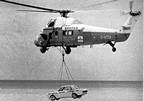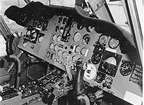BRISTOW OPERATIONS WITH WESTLAND WESSEX 60.
In 1988 Airlife Publishing Ltd. published a book by Patrick Allen titled
"Wessex"
which covered the development of the Wessex and although it mainly concentrated
on the military history of the aircraft, one chapter was devoted entirely
to Bristows operations of the Wessex 60. Most of the information for the
chapter came from Mr P N Hunt who presumably worked for Bristows at the
time and who provided company pictures and data.
So my thanks to him, Patrick Allen, Airlife Publishing (who have allowed
me to reproduce the article) and Les Smith for lending me the book.
And here it is ...............
 In
the early nineteen sixties Bristow Helicopters Ltd were looking for a
capable all weather helicopter to replace some of their existing fleet
which included the Westland Widgeon and Whirlwind. UK offshore oil exploration
was expanding with the opening of oil and gas sectors further from the
mainland which would require the support of a capable and safe helicopter.
In
the early nineteen sixties Bristow Helicopters Ltd were looking for a
capable all weather helicopter to replace some of their existing fleet
which included the Westland Widgeon and Whirlwind. UK offshore oil exploration
was expanding with the opening of oil and gas sectors further from the
mainland which would require the support of a capable and safe helicopter.
With the success of the twin engined Wessex which had just entered service
with the Royal Navy and the RAF the turbine powered Wessex was ideal for
offshore support work. The Wessex with its coupled powerplant and power
reserves made it ideal for over water operations and suitable for operations
at high altitudes and in high ambient temperatures. This was particularly
attractive to Bristows in their world wide commitments and for operations
over built up areas, and night or adverse weather flying.
The Wessex 60 was intended to support both the UK and overseas oil and
natural gas exploration taskings so this adverse weather, twin engined
capability made it ideal. For operations in remote areas the Wessex had
already proved itself within the Services operating out of Borneo and
Aden. With its long range tanks fitted it allowed the Wessex to service
rigs anything up to 230 miles from land.
The Wessex 60 was based on the Royal Air Force Wessex HC Mk2 but with
a host of extras to make it compatible for civil operations. This included
a full VFR/IFR avionics fit to allow the helicopter to operate to the
British Group 'A' Public Transport Standards under both Visual and Instrument
Flight rules. The Wessex 60 was designed to carry 10 passengers in comfort
or 16 in the utility role. It was also capable of taking eight stretchers,
two sitting casualties and a medical attendant. The helicopter was also
ideal for the carriage of freight both internally or underslung.
WESSEX 60 OPERATING HISTORY. 1965 - AUGUST 1981.
 First operated at Tetney, October 1965.
First operated at Tetney, October 1965.
Throughout its seventeen years' service with Bristows, the Wessex 60's
capability was enhanced by the incorporation of numerous avionic upgrades
which enabled operations in the most challenging of climatic conditions.
Bristow design department produced many modifications to the helicopter
throughout its service including some of the following :
additional lighting for night winching, ILS switch box modification, fitment
of adhesive tape to the leading edge of main rotor blades, prevention
of inadvertent operation of cabin door jettison handle, reposition of
the primary switch on the main transmission deck and new cable runs to
avoid battery corrosion to name but a few. The Bristow team at Redhill
in Surrey also converted a Wessex 53 built for Ghana into a Wessex 60
The Wessex 60 began its service with Bristows at Tetney, near Grimsby
on the UK east coast in October 1965 and from Great
Yarmouth (North Denes) where up to six Wessex operated serving North
Sea gas and oil rigs. The Wessex soon found its capabilities in use with
Bristows throughout the world. Its twin engine performance and long range
made it ideal for exploration work. This included jungle operations in
South America. The expertise of the Bristows aircrew, many of whom were
ex-military , came into its own. Many of the operations deep in the jungle
could only be supported by helicopters as no roads existed. This would
include the Wessex having to fly in portable accommodation units, drilling
equipment and then resupply the teams during operations.
 The Wessex worked throughout the Bristow area of operations not only in
the offshore support sector but also in the commercial Ad-Hoc role and
in the Flight Training School at the Company headquarters, Redhill, Surrey.
The Wessex worked throughout the Bristow area of operations not only in
the offshore support sector but also in the commercial Ad-Hoc role and
in the Flight Training School at the Company headquarters, Redhill, Surrey.
Although the majority of Wessex operations were in support of the oil
industry in its offshore support role the Wessex was regularly tasked
to undertake various roles associated with geophysical surveys, search
and rescue, aerial crane work and exploration. These duties required the
dedicated support of Bristows back up teams including engineering who
often had to work in some of the world's most inhospitable regions. Nothings
changed there then! ed.
Although many of the engineers were ex- military, Bristows trained
their own technicians to repair overhaul, inspect and test the complex
components and equipment of the helicopters.
For its work in the Far East and Australia the Wessex 60 was well suited
to operations in those hot climatic conditions. This was an important
consideration for a contract such as the "Woodside Offshore Petroleum
Company" contract at Port Samson, Tasman and Broome. The single engine
performance characteristics of the Wessex 60 enabled the maximum certificated
weight of 6,169kg (13,600lbs) to be maintained in temperatures up to 47C
at sea level and meet the one engine inoperative performance requirements
of the Development Charter Standards. The Wessex 60 allowed a deliberate
single engine landing on an offshore installation, and therefore, if there
was a second installation or vessel suitably located it would allow an
offshore diversion policy to be used, as opposed to carrying the fuel
necessary to divert to a land based alternative.
Dependent on ambient conditions and range this offshore diversion policy
could result in a significant increase in payload during these offshore
support tasks.
 For the Australian contracts the Wessex 60 had the following equipment
Radio/Navigation equipment fitted as standard: 2 off HF/SSB long range
communication systems (Sunair ASB 100), 2 off VHF
radios (King KTR 900), VOR/ILS/MKR (RCA AVM 21C), 2 off ADF receivers
(KDF 800), Weather Radar (Primus 21), Radio Altimeter (TRT AHV8), VHF
Homer ( Chelton system 7), DME (Van 5) and Cockpit Voice Recorder ( Fairchild
A100).
For the Australian contracts the Wessex 60 had the following equipment
Radio/Navigation equipment fitted as standard: 2 off HF/SSB long range
communication systems (Sunair ASB 100), 2 off VHF
radios (King KTR 900), VOR/ILS/MKR (RCA AVM 21C), 2 off ADF receivers
(KDF 800), Weather Radar (Primus 21), Radio Altimeter (TRT AHV8), VHF
Homer ( Chelton system 7), DME (Van 5) and Cockpit Voice Recorder ( Fairchild
A100).
Performance characteristics for the Australian offshore operations were
as follows:
Max Gross Take-off Weight: 6,169kg.
Normal Cruise Speed: 95 kts at 1000ft at ISA +15C.
Fuel consumption 483 lit/hr.
Fuel capacity with external aux tanks: 2,140 litres.
 The
Wessex 60 was the workhorse of the Company and totalled quite a record
before it was grounded in 1981.
The
Wessex 60 was the workhorse of the Company and totalled quite a record
before it was grounded in 1981.
After the third unexplained fatal accident, on the 13th August 1981 the
Company decided to withdraw the type from service and no more revenue
flights occurred after that date. The remaining aircraft which were operating
at Port Harcourt and Warri in Nigeria were ferried back to UK across the
Sahara during November 1981. Of the ten Wessex remaining with Bristows
seven were sold to Westland and three were sold onto Turbine
Support Limited on the Isle-of-Wight. Within Bristows the type was
replaced by types such as the Bell 212, Super Puma (Tiger) and S61s.
WESSEX OPERATIONS / ROLES.
 UK.
UK.
Aberdeen (various), Blackpool (Hydrocarbons), Haverfordwest, South
Wales (various), North Denes (Amoco various oil/gas support), Paull (BP),
Pembroke Dock (Shell), Peterhead (BP), Bristows, Redhill (Flight Training
School / Ad hoc), Scarborough (Burmah / Amoco), Isle of Skye (MOD), Southampton
(Hydrocarbons), Sumburgh (various), Sunderland (various), Tetnet (BP /
Burmah).
EUROPE.
Esbjerg, Denmark (Gulf), Cork, Eire (Marathon), Germany (Mobil), Holland
(not recorded), Las Palmas (Conoco and
ship support).
AFRICA.
Ghana, Accra (Amos), Guinea Bissau (Esso), Mauritania (Esso), Port Harcourt
and Warri, Nigeria (Shell), Durban, South Africa (Shipping servicing,
supply / crew changes at sea).
AUSTRALIA.
Barrow Island (Wapet), Broome (Woodside Offshore Petroleum
/ BOC), Ceduna (Cutback Shell), Jandakott (Phillips), Karratha (Woodside
/ Hudbay), Port Hedland (Stirling Oil / BP), Port Samson (Bocel / Woodside),
Tasman (Woodside / Bocal), Wyndham (Arco), Perth (Bopal / Wapet).
ASIA.
Bangladesh, Dhaka (Crown Agents), India Bhubaneswar (Natomas), Indonesia,
Natuna (Agip / Continental), Duri (CPI), Djambi (Total), Malaysia, Kuantan,
(Conti / Conocco), Miri (Shell), Trengganu (Esso), Phillipines, Manila
(Bhopil), Thailand, Nakhon (Conoco), Songkhla (Triton).
SOUTH AMERICA.
Equador (Minas / Anglo), Guyana (Shell), Surinam (Elf), Trinidad (Deminex).
MIDDLE EAST.
Das Island, Gulf (Superior), Muscat (Wintershall), Yemen (Shell).
WESTLAND WESSEX 60 (SPECIFICATIONS)
 Total
built by Westland Ltd: 15.
Total
built by Westland Ltd: 15.
One conversion by Bristows from Wessex 53.
Service Dates: October 1965 -13th August 1981.
Standard Equipment.
The Wessex 60 was designed as a 16 passenger seat helicopter, powered
by two Rolls-Royce "Gnome" Mk 660, 1350 shp free turbine engines.
Its specification made it eligible to hold a valid Public Transport Certificate
of Airworthiness and a British Group 'A' Public Transport Certificate
for both Visual and Instrument Flight Rules. The Group 'A' performance
ensured that the helicopter was safe throughout the flight envelope in
the event of a single engine failure.
Radio Communication and Navigational Equipment.
 1.-
1 FM Radio Transceiver.
1.-
1 FM Radio Transceiver.
2.- 2 VHF Radio Transceivers (King KTR 905).
3.- 1 ADF Receiver (KDF 805).
4.- 1 VOR/ILS/Marker installation (Collins VIR 30A).
5.- Decca Mk 15 installation.
Safety and Survival Equipment.
1.- Emergency floatation equipment.
2.- 18 man liferaft with distress beacon and survival pack.
3.- Passenger life jackets and crew life jackets with Sarbe beacons.
4.- Sonar Underwater locator.
5.- 2 Fire Extinguishers / 2 First Aid kits / Schermuly Flares.
Special Equipment Ordered as Standard.
- Ferranti Stability Augmentation System.
- IFR electrics.
- Anti-icing Nose Door installation.
- Dual Pilot controls and Dual Instrumentation.
- Rotorbrake.
- Pilot and passenger Intercommunication System.
- Public Address system.
- Cabin soundproofing and trim.
- 16 place Mulliner Park Ward passenger seats.
- Cabin Heater.
- Ply Board protective cabin floorboards.
- Fixed fittings for Cargo Hook and Rescue Hoist.
- Cargo Hook.
- Rescue Hoist.
Performance Characteristics.
- Maximum Gross Take-off weight 13,600 lbs.
- Normal cruise speed 100kts.
- Approx. Fuel consumption 840 lbs / hr.
- Fuel capacity 2,450 lbs.
- For routine operations the Wessex 60 was limited for rotor engagement
to gusting windspeeds not exceeding 45 kts, with a maximum constant airspeed
for departure of 55 kts.
Wessex 60 Operating Figures. (summary)
The Bristow Wessex fleet peaked at 15 aircraft in the early seventies
with annual flying hours peaking at 13,500 in 1972. In 1978, the annual
number of passengers carried was a record 153,396 although the Wessex
fleet was down to 13 aircraft.
The final totals for the Wessex fleet over its seventeen year run are
as follows:
- Total Hours 141,128.
- Sectors Flown 239,232.
- Passengers 1,500,518.
- Freight (lbs) 86,903,646.
Minor editorial changes made for web site readability. DE.